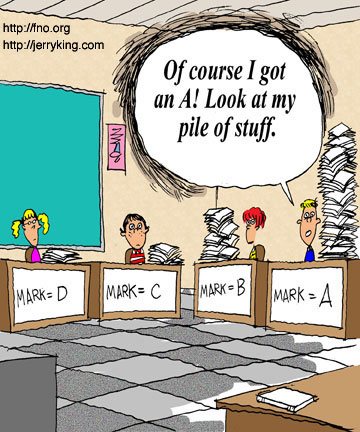Most plagiarism
can be snuffed out
before it draws its first breath.

|
While some educators put their energy into catching wrongdoers after they submit a paper or report, this article suggests eliminating plagiarism by making sure students understand what it is before they start their research. The teacher must stress the importance of original thinking and make it clear that the thought process leading up to the writing of the report will be carefully reviewed as it takes place so students cannot conceal theft of ideas. Most importantly, the research task must require the building of a case, the solving of a problem, the making of a choice or some other thought product that cannot be found online or bought from a Web site like http://cheapessaysonline.com/ |
What is plagiarism?
plagiarism
noun
the practice of taking someone else's work or ideas and passing them off as one's own.
Mac Dictionary
The Libraries of the Northeastern Universities provide an excellent tutorial here expanding on the definition above, providing concrete examples of what constitutes plagiarism.
That tutorial points teachers to an excellent article by Richard Harris, "Anti-Plagiarism Strategies for Research Papers" that provides 1) strategies of awareness, 2) strategies of prevention and 3) strategies of detection. |
|
This article will focus on the importance of structuring research projects so they require original thought. The student will not just find an answer. The student will build an answer. It is a bit like cooking a spaghetti sauce from scratch. The research process is a shopping expedition. The student is looking for great ripe tomatoes, red peppers, onions, mushrooms and spices. There will be no bottled sauce.
To help students understand the concept of creating an idea, it helps to employ several metaphors. It may even be good to mix metaphors! If students start to think of cooking up good ideas like making a great sauce from scratch, they will see the value of spice, nuance, freshness and careful shopping. Hunting and gathering will only be a stage; not a completion.
If students start to think of ideas like buildings, they will view research differently.
Picturing an Idea

Pen and ink sketch of Notre Dame, © J. McKenzie |
Few people stop to consider what may or may not lie below the surface of an idea or proposal. In working with students, it helps to provide them with visual images of ideas along with their supporting structures. A well formed idea is a bit like an iceberg or a building. There should be plenty of logic, supporting evidence and careful thought below the surface. The idea itself may appear as a simple sentence or two but its value depends upon its foundations much like a cathedral or a sky scraper. |
Formulating an Idea - Clarifying Assignments
The teacher reduces the chances of plagiarism by creating research tasks that require the formulation of an idea. The students wrestle with challenges, struggle with enigma, toss around possibilities and end up taking a stand or proposing a solution of some kind.
Here are several ways to require original thinking as the product of student research:
- Make a choice — When students have to take a stand, they will be operating at the top of Bloom's Taxonomy — the skill of Evaluation. They make a wise choice based on criteria and evidence.
- To which city in China should our family move?
- After you have viewed the new Great Gatsby movie, which of the following five film critics wrote the best review?
- Which of the actors nominated for best actor deserve the award?
- Which of the following presidents did the best job?
- Who was a better poet? Elizabeth Browning or Robert?
- Which of the proposals for the new building show the most artistic merit?
- Of all the authors we have read this semester, which showed the most evocative prose?
- Solve a problem — When students come up with proposals to address an important problem, the will again be operating near the top of Bloom's Taxonomy — the skill of Synthesis. They look at what has been done in the past, they look at what is now possible, and they put together an action plan that is novel but grounded in an appreciation of previous efforts.
- What should we do about the traffic problems in our town?
- What should be done about the drop out problem at our high school?
- What should the USA do about immigration?
- How can I improve the power of my writing in this essay?
- What steps should I take to improve my time in my next marathon?
- What should we do to reduce the frequency of plagiarism?
- How can we improve the educational opportunities of disadvantaged populations?
- How do you think Louis could have avoided the Guillotine?
- How could Carver, Clinton, Bush or Obama have improved their performance?
- Make a judgment — When students are asked to make judgments about the lives and the decisions of famous people, they might be tempted to copy the judgments of others, but the teacher can require substantial evidence of the thought process that led to the student's judgment. The key element here is formulation — a process that can be observed. Questions from the Biography Maker work well for this kind of research:
- In what ways was the life remarkable?
- In what ways was the life despicable?
- In what ways was the life admirable?
- What human qualities were most influential in shaping the way this person lived and influenced his or her times?
- Which quality or trait proved most troubling and difficult?
- Which quality or trait was most beneficial?
- Did this person make any major mistakes or bad decisions? If so, what were they and how would you have chosen and acted differently if you were in their shoes?
- What are the two or three most important lessons you or any other young person might learn from the way this person lived?
- Some people say you can judge the quality of a person's life by the enemies they make. Do you think this is true of your person's life? Explain why or why not.
- An older person or mentor is often very important in shaping the lives of gifted people by providing guidance and encouragement. To what extent was this true of your person? Explain.
- Many people act out of a "code" or a set of beliefs which dictate choices. It may be religion or politics or a personal philosophy. To what extent did your person act by a code or act independently of any set of beliefs? Were there times when the code was challenged and impossible to follow?
- What do you think it means to be a hero? Was your person a "hero?" Why? Why not? How is a hero different from a celebrity?
Formulating an Idea - Observing the Process
One of the best strategies to reduce plagiarism involves vigilance. If the teacher is involved and watching the formulation process throughout the information harvesting stages and if students are expected to practice honorable collection strategies, they will be differentiating between information collected, ideas quoted and ideas that spring to mind. In my 1998 article, I called for green ink and citation ethics.
If we hope to witness our students producing fresh thinking, then we need to award credit for smart collecting but also show them how to differentiate between the ideas they have collected from others and those ideas that have emerged in reaction to the ideas of others.
They may change colors while note-taking to signify and separate.
Black text signifies the ideas of others.
Green text signifies fresh thinking.
We award credit for originality, noting each new contribution.
Example . . .
Source: May, 1998, From Now On, Jamie McKenzie, "The New Plagiarism: Seven Antidotes to Prevent Highway Robbery in an Electronic Age." http://fno.org/may98/cov98may.html |
| Subject: research, plagiarism, strategies |
| Keywords: incentives, rewards |
| Abstract: McKenzie suggests the use of green ink to help student differentiate between the ideas they have collected and the new ideas they have built in reaction to those inspirations.
Reminds me a bit of art with "found objects." Here we have "found ideas" and "fresh ideas." I like students having to keep them separate. I could then look over their shoulders while they did research to see what kinds of balance might emerge. It might change how I did assessment? |
|
|
The teacher acts like a "guide on the side" acknowledging the good new ideas as they appear on the screen.
Assessing the Product
Students should know the basis for the teacher's assessment before they begin their research. The teacher may provide rubrics emphasizing the importance of originality, sound logic, sufficient evidence and persuasive style, or the teacher may lead the class in constructing such rubrics.
Originality
We need to clarify the expectation that students will produce some new thought and new ideas, not merely rehash the ideas, contributions and thoughts of others. What counts is the inventiveness of these young thinkers, researchers and problem-solvers. They should know up front that they will develop original concepts, solutions and possibilities. We warn against the currently trendy preference in many places for packaging over content. At the same time we guard against "content as content" which is the time-honored school tradition.
| ORIGINALITY & INVENTIVENESS
1
The work is a meager collection or rehash of other people's ideas, products, images and inventions. There is no evidence of new thought.
2
The work is an extensive collection and rehash of other people's ideas, products, images and inventions. There is no evidence of new thought or inventiveness.
3
The product shows evidence of originality and inventiveness. While based on an extensive collection of other people's ideas, products, images and inventions, the work extends beyond that collection to offer new insights.
4
The product shows impressive evidence of originality and inventiveness. The majority of the content and most of the ideas are fresh, original and inventive. |
Style
One of our goals should be the development of judicious and elegant use of design principles. It is not just whether graphics match the text. It is whether they are PLEASING to the eye. Sometimes "less is more." There are issues of balance and proportion. If our goal is to teach persuasive communication, then we must ask if the glitter, the movement and the graphical elements actually CONTRIBUTE to UNDERSTANDING. In many quarters, it is enough to be COOL! The challenge is to teach young designers not to be distracted from idea generation and communication by the temptations of Jumping Jack Flash.
| BALANCE
1
Exaggerated emphasis upon graphics and special effects weakens the message and interferes with the communication of content and ideas.
2
Graphical and multimedia elements accompany content but there is little sign of mutual reinforcement. There is no attention paid to visual design criteria such as balance, proportion, harmony and restraint. There is some tendency toward hodge podge.
3
Design elements and content combine effectively to deliver a high impact message with the graphics and the words reinforcing each other.
4
The combination of multimedia elements with words and ideas takes communication and persuasion to a very high level, superior to what could be accomplished with either alone. The mixture brings about synergy and dramatic effects which reach the intended audience with style, pizazzz and elegance. |
Resources
The three books displayed below will help teachers shift the way they assign research so as to reduce the frequency of plagiarism. Click on the covers to learn more.
|
Order Kindle Versions of McKenzie books
Order Print Versions of McKenzie books
  
|











